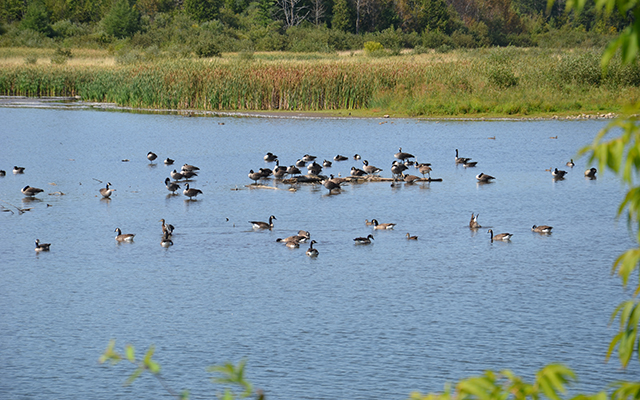
Back in the late 1960s, I really got into waterfowling, which actually meant duck hunting. Seeing a Canada goose in Aroostook County was a rare occurrence, and actually getting a shot at one was extremely unlikely. During the 1980s and early 90s, my hunting buddies and I trekked annually to Maryland’s eastern shore, Connecticut and New York’s Finger Lakes region to quell our honker hunting desires.
It was during the mid-80s when Maine wildlife biologists began trapping, transporting and transplanting nuisance geese from other New England states. These small bunches of imported birds grew, multiplied and spread out into larger flocks of native geese throughout The Crown of Maine and kept returning each year. As the saying goes, ”the rest is history.” In 1996, Maine had its very first September “early “ goose season. This year’s native goose hunt is currently underway and all you need is a shotgun, a few decoys and your federal and state duck stamps to enjoy the thrill and challenge of honker hunting.
Aroostook’s abundance of crop fields and waterways offers perfect habitat for waterfowl, and the regular seasons for ducks and geese will begin the first week of October and run for several weeks. Wildfowl numbers will explode regionally as migrating birds stop to feed and fatten until snow or frozen ground and ice-covered waterways send them winging further south. Since many local outdoorsmen turn their time and interest to partridge, woodcock, ducks, deer and moose in October and November, the native goose season this month offers a perfect diversion.
There are a few pros and cons to be considered by goose gunners during this early season. There are fewer total geese around than during the later migration flights. Add that to the vast number of grain fields and other agri-crop fields offering food sources and it’s often tough to select a site to set up decoys. Scouting is a must to pinpoint birds and favored feeding locations, but it’s less than a 50-50 chance that if you spot birds in the evening, they will return the next morning to the same location.
Also flocks are much smaller, often 12 to 25 geese total, and usually where the old gander leads, the rest follow. Later on when flocks on roost ponds number several hundred, it’s possible to coax a few from passing flights as birds leave the water in small bunches and travel in all directions to find food. One positive about this month’s goose season is that a lot of the birds are young and although they appear full grown. they are not as wary, and more easily fooled by decoy set ups and good calling.
Another plus of this early season is that the small flocks respond well to smaller decoy spreads and hunters can often coax geese into range with as few as 12 to 18 fake silhouette and shell style decoys, which are much easier to carry and set up for field hunts. Late season geese have seen plenty of decoys and often survived numerous shotgun barrages during their migration travels. They are educated and often investigate only very large decoy spreads of realistic flocked, full-body replicas — expensive gear that takes a lot of time to set out and pick up.
Geese spend their nights on ponds, rivers and lakes to be safe from land-bound predators, flying out each morning to find food. After feeding, the flocks return to the water to drink and then rest in the sun until it’s time to wing away and eat again in the late afternoon. Once the geese all vacate their favorite roost waterway, it’s possible for hunters to set up some floating decoys, hide along the shoreline or in a well camouflaged boat and enjoy some shooting as the honkers return in small groups.
Discretion must be exercised when gunning roost waters. Visit more than twice in a week and the gunfire will often cause the geese to relocate. Sometimes a good alternative is to scout the stream or pond and learn which route the birds use to leave and return, then set up in a hedgerow, wood line or makeshift blind at least 100 yards away from water along the flight path. Pass shooting from a distance is far less likely to disrupt the roost and rest area, and may be used morning and afternoons as flocks exit and return to home waters.
Twelve gauge shotguns with three-inch shells are the most common firearm for big, tough honkers and a few shooters step up to 3-1/2 inch 12s or even a big bore 10 gauge. Youngsters and small-framed women may prefer a 16 gauge or 20 with three-inch shells for less recoil abuse. Steel shot is a must per state and federal regulations and size two or BB shot are best for quick, lethal loads. There are copper-coated pellets and non-toxic alternatives such as bismuth, and a couple of tungsten combinations that are even more effective for tough waterfowl, albeit notably more expensive than steel.
Along with your shotgun, shells and decoys, the only other essential for steady success is camouflage clothing. Regardless if a layout blind or natural cover is to be used to hide a hunter, camo truly helps a shooter blend in, especially a cap, face mask, or face paint and lightweight shooting gloves. A goose call will help, but only if a hunter takes time to learn just a couple of basic hail, greeting, and feeding honks, chirps and chuckles.
Early season goose hunting runs to Sept. 25 and there’s a six bird per day limit. As the geese begin to bunch into larger flocks, the last couple of weeks might just offer better gunning opportunities. Waterfowl wing shooting offers a wonderful challenge for sportsmen of all ages, and if you’ve never tasted a roast, stuffed Canada goose, prepared properly it’s a true taste treat.






